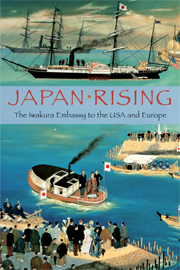Book contents
- Frontmatter
- Contents
- Introduction by Ian Nish
- Note on the Text
- VOLUME I THE UNITED STATES OF AMERICA
- VOLUME II BRITAIN
- VOLUME III CONTINENTAL EUROPE, 1
- VOLUME IV CONTINENTAL EUROPE, 2
- VOLUME V CONTINENTAL EUROPE, 3; AND THE VOYAGE HOME
- 82 The Vienna Universal Exposition, 1
- 83 The Vienna Universal Exposition, 2
- 84 A Record of Switzerland
- 85 Switzerland's Mountain Scenery
- 86 A Record of Berne and Geneva
- 87 A Record of Lyons and Marseilles
- 88 Spain and Portugal
- 89 Political Practices and Customs in Europe
- 90 European Geography and Transportation
- 91 The Climate and Agriculture of Europe
- 92 European Industry
- 93 European Commercial Enterprise
- 94 The Voyage Through the Mediterranean
- 95 The Voyage Through the Red Sea
- 96 The Voyage Through the Arabian Sea
- 97 A Record of the Island of Ceylon
- 98 The Voyage Through the Bay of Bengal
- 99 The Voyage Through the China Sea
- 100 A Record of Hong Kong and Shanghai
- Index
100 - A Record of Hong Kong and Shanghai
Published online by Cambridge University Press: 04 August 2010
- Frontmatter
- Contents
- Introduction by Ian Nish
- Note on the Text
- VOLUME I THE UNITED STATES OF AMERICA
- VOLUME II BRITAIN
- VOLUME III CONTINENTAL EUROPE, 1
- VOLUME IV CONTINENTAL EUROPE, 2
- VOLUME V CONTINENTAL EUROPE, 3; AND THE VOYAGE HOME
- 82 The Vienna Universal Exposition, 1
- 83 The Vienna Universal Exposition, 2
- 84 A Record of Switzerland
- 85 Switzerland's Mountain Scenery
- 86 A Record of Berne and Geneva
- 87 A Record of Lyons and Marseilles
- 88 Spain and Portugal
- 89 Political Practices and Customs in Europe
- 90 European Geography and Transportation
- 91 The Climate and Agriculture of Europe
- 92 European Industry
- 93 European Commercial Enterprise
- 94 The Voyage Through the Mediterranean
- 95 The Voyage Through the Red Sea
- 96 The Voyage Through the Arabian Sea
- 97 A Record of the Island of Ceylon
- 98 The Voyage Through the Bay of Bengal
- 99 The Voyage Through the China Sea
- 100 A Record of Hong Kong and Shanghai
- Index
Summary
August 27th, 1873. Fine.
At nine o'clock in the morning we berthed at Hong Kong. At ten we went ashore and took rooms at the Hotel de Hong Kong.
At daybreak we had found ourselves passing among a multitude of mountainous islands, large and small, scattered over the sea. The mountains were all covered in grass, but there were no trees. The shapes of the steep mountains on the mainland around Canton were very graceful. Among their folds were fallen rocks looking just like the brushed dots in a Chinese landscape painting. For the first time we could see where the Chinese style of painting had its origins.
China ceded Hong Kong to Britain in 1841. The British then built a harbour here, and the population has increased over the years to 126,051. Most of these are Chinese. The mountains here are all high and steep. There is no land fit for cultivation, and very few trees. There are no rivers, but a plentiful supply of clean water is piped to the city from reservoirs. Granite is quarried in the mountain valleys, and the buildings constructed by the British with this stone are beautifully white and clean. The British began building stone houses to rent to the Chinese some time ago because wooden houses so easily caught fire. As a result, the streets are clean even though most of the inhabitants of the city are Chinese.
- Type
- Chapter
- Information
- Japan RisingThe Iwakura Embassy to the USA and Europe, pp. 517 - 523Publisher: Cambridge University PressPrint publication year: 2009



